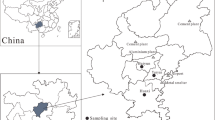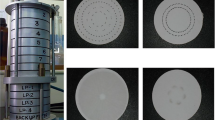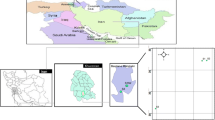Abstract
Comprehensive two-dimensional gas chromatography (GC × GC) utilizing a flow modulator was applied to study particulate polycyclic aromatic hydrocarbons (PAHs) and n-alkanes in the urban atmosphere. Samples were collected onto quartz fiber filters using a PM2.5 sampler at Megacity Shanghai, China. Sample preparation included extraction into n-hexane-dichloromethane mixture and cleanup on silver-impregnated silica column. Analyses were performed well with GC × GC-FID and GC × GC-TOFMS equipment. Average particulate PAHs and n-alkane concentrations were in the range of 40–100 ng/m3 and 120–500 pg/m3, respectively. It is alarming to note that PAHs and n-alkane concentrations were increasing with urban PM2.5 values and exceeded the air quality standards in many sampling events. Among them, 2-ring, 3-ring, and 4-ring PAHs accounted for the majority of total PAHs, and C10–15 accounted for the majority of particulate n-alkanes. Potential sources of PAHs in PM2.5 were identified using the diagnostic ratios between PAHs. Local emission sources such as combustion from gasoline and diesel engines were the main contributors of particulate-associated PAHs, while long-range transport had minor contribution to the particulate PAHs. Additionally, we determined the overall carcinogenicity of the samples based on PAH concentrations by a dose addition model and found that the overall carcinogenicity during polluted period was obviously higher than during good air quality period.







Similar content being viewed by others
References
Adahchour M, Beens J, Brinkman UAT (2008) Recent developments in the application of comprehensive two-dimensional gas chromatography. J Chromatogr A 1186(1–2):67–108
Bakeas EB, Siskos PA (1996) A four factor simplex optimization of a serially coupled open tubular columns gas chromatographic system. Hrc-J High Resolut Chromatogr 19(5):277–283
Borras E, Tortajada-Genaro LA (2007) Characterisation of polycyclic aromatic hydrocarbons in atmospheric aerosols by gas chromatography-mass spectrometry. Anal Chim Acta 583(2):266–276
Burkart K, Nehls I, Win T, Endlicher W (2013) The carcinogenic risk and variability of particulate-bound polycyclic aromatic hydrocarbons with consideration of meteorological conditions. Air Qual Atmos Health 6(1):27–38
Callén MS, López JM, Iturmendi A, Mastral AM (2013) Nature and sources of particle associated polycyclic aromatic hydrocarbons (PAH) in the atmospheric environment of an urban area. Environ Pollut 183:166–174
Deng WJ, Louie PKK, Liu WK, Bi XH, Fu JM, Wong MH (2006) Atmospheric levels and cytotoxicity of PAHs and heavy metals in TSP and PM2.5 at an electronic waste recycling site in southeast China. Atmos Environ 40(36):6945–6955
Galarneau E (2008) Source specificity and atmospheric processing of airborne PAHs: implications for source apportionment. Atmos Environ 42(35):8139–8149
Gomes da Silva MDR, Cardeal Z, Marriott PJ (2008) Comprehensive two-dimensional gas chromatography. Appl Aromat Essent Oil Anal 988:3–24
Hamilton JF (2010) Using comprehensive two-dimensional gas chromatography to study the atmosphere. J Chromatogr Sci 48(4):274, −+
Hyder M, Aguilar LL, Genberg J, Sandahl M, Wesen C, Jonsson JA (2011) Determination of polycyclic aromatic hydrocarbons (PAHs) from organic aerosols using hollow fiber micro-porous membrane liquid-liquid extraction (HF-MMLLE) followed by gas chromatography-mass spectrometry analysis. Talanta 85(2):919–926
Jacob J, Greim H (2004) Verwendung eines auf Wirkungsäquivalenten basierenden Summenparameters für die Abschätzung der PAH-Exposition und ihres Krebs erregenden Potenzials. In: Jacob J, Greim H (eds) Polycyclische aromatische Kohlenwasserstoffe (PAH). Wiley-VCH, Weinheim
Jacob, J., Seidel, A. (2006). Verwendung eines auf Wirkungsäquivalenten basierenden Summenparameters für die Abschätzung der PAH-Exposition und ihres Krebs erregenden Potenzials. In Polycyclische aromatische Kohlenwasserstoffe (pp. 8–26): Wiley-VCH Verlag GmbH & Co. KGaA.
Jiang YL, Hou XM, Zhuang GS, Li J, Wang QZ, Zhang R et al (2009) The sources and seasonal variations of organic compounds in PM2.5 in Beijing and Shanghai. J Atmos Chem 62(3):175–192
Kallio M, Hyötyläinen T (2008) Simple calibration procedure for comprehensive two-dimensional gas chromatography. J Chromatogr A 1200(2):264–267
Karanasiou AA, Sitaras IE, Siskos PA, Eleftheriadis K (2007) Size distribution and sources of trace metals and n-alkanes in the Athens urban aerosol during summer. Atmos Environ 41(11):2368–2381
Krupcik J, Gorovenko R, Spanik I, Sandra P, Armstrong DW (2013) Flow-modulated comprehensive two-dimensional gas chromatography with simultaneous flame ionization and quadrupole mass spectrometric detection. J Chromatogr A 1280:104–111
Li X, Li PF, Yan LL, Chen JM, Cheng TT, Xu SF (2011) Characterization of polycyclic aromatic hydrocarbons in fog-rain events. J Environ Monit 13(11):2988–2993
Liao WC, Ou-Yang CF, Wang CH, Chang CC, Wang JL (2013) Two-dimensional gas chromatographic analysis of ambient light hydrocarbons. J Chromatogr A 1294:122–129
Lin T, Hu L, Guo Z, Zhang G, Yang Z (2013) Deposition fluxes and fate of polycyclic aromatic hydrocarbons in the Yangtze River estuarine-inner shelf in the East China Sea. Glob Biogeochem Cycles 27(1):77–87
Masiol M, Centanni E, Squizzato S, Hofer A, Pecorari E, Rampazzo G et al (2012) GC-MS analyses and chemometric processing to discriminate the local and long-distance sources of PAHs associated to atmospheric PM2.5. Environ Sci Pollut Res 19(8):3142–3151
Mazquiaran MAB, de Pinedo LCO (2007) Organic composition of atmospheric urban aerosol: variations and sources of aliphatic and polycyclic aromatic hydrocarbons. Atmos Res 85(3–4):288–299
Mesquita SR, van Drooge BL, Reche C, Guimarães L, Grimalt JO, Barata C et al (2014) Toxic assessment of urban atmospheric particle-bound PAHs: relevance of composition and particle size in Barcelona (Spain). Environ Pollut 184:555–562
Pietrogrande MC, Mercuriali M, Perrone MG, Ferrero L, Sangiorgi G, Bolzacchini E (2010) Distribution of n-alkanes in the Northern Italy Aerosols: data handling of GC-MS signals for homologous series characterization. Environ Scie Technol 44(11):4232–4240
Shimmo M, Adler H, Hyotylainen T, Hartonen K, Kulmala M, Riekkola ML (2002) Analysis of particulate polycyclic aromatic hydrocarbons by on-line coupled supercritical fluid extraction-liquid chromatography-gas chromatography-mass spectrometry. Atmos Environ 36(18):2985–2995
Tobiszewski M, Namiesnik J (2012) PAH diagnostic ratios for the identification of pollution emission sources. Environ Pollut 162:110–119
Wang XY, Li QB, Luo YM, Ding Q, Xi LM, Ma JM et al (2010) Characteristics and sources of atmospheric polycyclic aromatic hydrocarbons (PAHs) in Shanghai, China. Environ Monit Assess 165(1–4):295–305
Xu X, van Stee LLP, Williams J, Beens J, Adahchour M, Vreuls RJJ et al (2003) Comprehensive two-dimensional gas chromatography (GC x GC) measurements of volatile organic compounds in the atmosphere. Atmos Chem Phys 3:665–682
Yunker MB, Macdonald RW, Vingarzan R, Mitchell RH, Goyette D, Sylvestre S (2002) PAHs in the Fraser River basin: a critical appraisal of PAH ratios as indicators of PAH source and composition. Org Geochem 33(4):489–515
Acknowledgments
This work was supported by the National Natural Science Foundation of China (Nos. 21177025, 21377028), the Excellent Academic Leader Program (No. 14XD1400600), and the Major Research Project (No. 12DJ1400100) of Science and Technology Commission of Shanghai Municipality.
Author information
Authors and Affiliations
Corresponding author
Additional information
Responsible editor: Constantini Samara
Rights and permissions
About this article
Cite this article
Xu, T., Lv, Y., Cheng, T. et al. Using comprehensive GC × GC to study PAHs and n-alkanes associated with PM2.5 in urban atmosphere. Environ Sci Pollut Res 22, 5253–5262 (2015). https://doi.org/10.1007/s11356-014-3695-9
Received:
Accepted:
Published:
Issue Date:
DOI: https://doi.org/10.1007/s11356-014-3695-9




